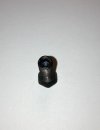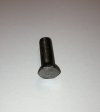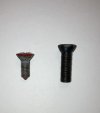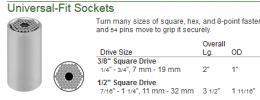I am bringing this back up to the top, as I may have found a solution to the age old problem of getting doors adjusted once they have been completely removed. If you read my last comment above, you will see that I was very intrigued by Ken Ellis' idea of machining a hex profile into the end of a screw in order to tighten them from the inside. As I said in January, "I don't have the tools or the talent" for the job, but that didn't stop me from thinking about a solution.
My first thought was to try to file/grind a hex profile by hand, but doubted I could pull that off. I also considered finding a very small nut and welding that to the end of a screw, but doubted I could do that with my welding equipment or skills. That let me to think about a simple solution, just cutting a slot into the end of a screw and using a flat head screw driver. I wasn't sure that would be strong enough, but that image made me think of ordinary set screws. What I was trying to design was just a set screw with a flat head screw head on the other end. So, instead of trying to machine something into the butt end of a screw, why not just use a standard set screw and figure out a way to make an appropriate head for that?
I went to Ace Hardware and picked up a handful of allen head 5/16-24 set screws for about $0.70 each. I then took a couple of 5/16 nuts and attached them to the end of a bolt, locking the two together so that one was basically flush with the end of the bolt. Holding the end of the bolt I was then able to pretty quickly grind the nut down at about a 45 degree angle until it approximated the head of the original door bolt. I got it close by hand, then removed the nuts and re-attached them to a bolt with the head cut off. I chucked this into my drill press and used a file to smooth my grinds and to make the nut more symmetrical than I'd been able to do with the grinding wheel. Obviously, this would have been a lot easier with a small metal cutting lathe, but I don't have one and had to improvise. The picture below shows the nut/bolt attachment after smoothing in my poor man's lathe.

Note that I left just a bit of the flats on the nut. I didn't do this the first time, then had to mangle the nut removing it from the bolt with a vice grips. the stock nuts have a rounded profile on top and there is plenty of room in the hinge area to leave part of the hex profile in place. (This also helps when screwing them into the doors.)
Step two is to just screw the set screw into the nut, making sure the allen head end goes in first so that it is now the tip end of the new screw. I screwed it in a little past the end of the nut, so that there was room to weld it a bit. A couple of seconds with my mig welder and the two were attached very firmly. I then ground the end flat again, and just for good measure chucked the screw back into my drill press to file the end completely flat. Here are a couple of pictures of the end product next to the stock original:


I did all of this work about a month ago and made four screws, but didn't have a chance to try out Ken's method until just a few days ago. I put one screw in each leg of the hinges and loosened the remaining screws enough to allow the door to be easily moved into position. Then, with my wife holding the door in place, I tightened each one of the set screws from the inside. This is very doable if the car has no interior, which is the case with my S3. It only took us about 15 minutes to get the door about 95% perfect! I don't think 100% perfect is possible in my case, as the PO painted the door jambs, doors and hinges before re-assembling the car.
I also learned that the process would be even easier and more accurate with two helpers - one to hold the front in position and one to hold the back. At this point, I wasn't worried about trying to get it spot on; I only wanted to prove to myself that I could do it. Now I can remove the doors in good conscience and get the car up on the lift. I'll worry about getting everything perfectly positioned when I get to that point.
Hope this helps someone else. Based on what I've read here, I would guess that the total time to make the screws and adjust the doors is still less than doing it the traditional way.









